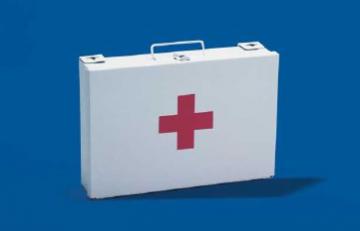A fracture is a break or crack in a bone that can be caused by an accident, fall, or blow. Symptoms include a snapping sound as bone breaks, bone protruding from skin, detectable deformity of bone, abnormal movement of bone, grating sensation during movement, pain and tenderness, difficulty in moving or using the affected part, swelling, and discoloration.
A sprain refers to stretched or torn tendons, ligaments, and blood vessels around a joint and can be caused by an accident, fall, or blow. Symptoms of a sprain include pain, tenderness, swelling, and discoloration in the joint area.
A muscle strain refers to stretched or torn muscle. It can be caused by excessive physical effort or improper posture during activity. Symptoms include pain, stiffness, and possibly swelling in the affected area.
It is sometimes difficult to tell the difference between a fracture and a sprain or strain until an X-ray has been performed. If you cannot tell, treat it as a fracture.
Fracture:-
SEEK MEDICAL ATTENTION IMMEDIATELY. Call for EMS, or transport victim to emergency room after immobilizing affected area. Wait for EMS and DO NOT attempt to transport victim if you suspect head, back, or neck injury; if there's a visible deformity of bone; or if the victim cannot be splinted or transported without causing more pain.
-
Suspect back or neck injury if victim is unconscious or has head injury, neck pain, or tingling in arms or legs. If neck or back injury suspected, DO NOT move victim unless necessary to save victim's life. See back or neck injury.
-
Immobilize and support affected bone in position found. DO NOT try to push protruding bone back into body or let victim move or use affected area.
-
Control any bleeding through direct pressure, but DO NOT elevate affected area. See bleeding,external.
-
If bone is protruding, cover with clean cloth once bleeding is controlled.
-
Observe for shock (see shock). DO NOT give victim anything to eat or drink.
-
Immobilize injured area, and, if no open wound present, apply ice pack wrapped in clean cloth.

Apply ice pack to affected
area and cover with cloth.
|
Immobilizing Fractured Bone:
-
Check for sensation, warmth, and color of toes or fingers below suspected break.
-
Place padded splint under area of suspected break:

Use belts or neckties
to bind splint
to arm but do not bind
on top of the break.
|
-Use board, rolled newspaper or magazines, broomstick, or rolled blanket for splint.
-Wrap splint in cloth or towels for padding.
-Bind splint to limb using neckties, cloth, belts, or rope. DO NOT bind directly over break.
- Recheck often for sensation, warmth, and coloring. If fingers or toes turn blue or swell, loosen binding.
-
For arm or shoulder injury, place splinted arm in sling, with hand above elbow level. Bind arm to victim's body by wrapping towel or cloth over sling and around upper arm and chest; tie towel or cloth under victim's opposite arm.

Create a sling for arm
injuries using whatever
cloth you can find.
|
Sprain or Strain:-
Have victim rest, with affected area elevated.

Keep the affected area elevated
and the victim at rest.
|
-
Apply cold compress or ice pack wrapped in cloth to affected area.

Use an ice pack or cold compress
to combat pain and swelling.
|
-
If pain or swelling continue for more than 2 days, consult doctor.
To learn more about first aid and emergency care, see:
This information is solely for informational purposes. IT IS NOT INTENDED TO PROVIDE MEDICAL ADVICE. Neither the Editors of Consumer Guide (R), Publications International, Ltd., the author nor publisher take responsibility for any possible consequences from any treatment, procedure, exercise, dietary modification, action or application of medication which results from reading or following the information contained in this information. The publication of this information does not constitute the practice of medicine, and this information does not replace the advice of your physician or other health care provider. Before undertaking any course of treatment, the reader must seek the advice of their physician or other health care provider.





































